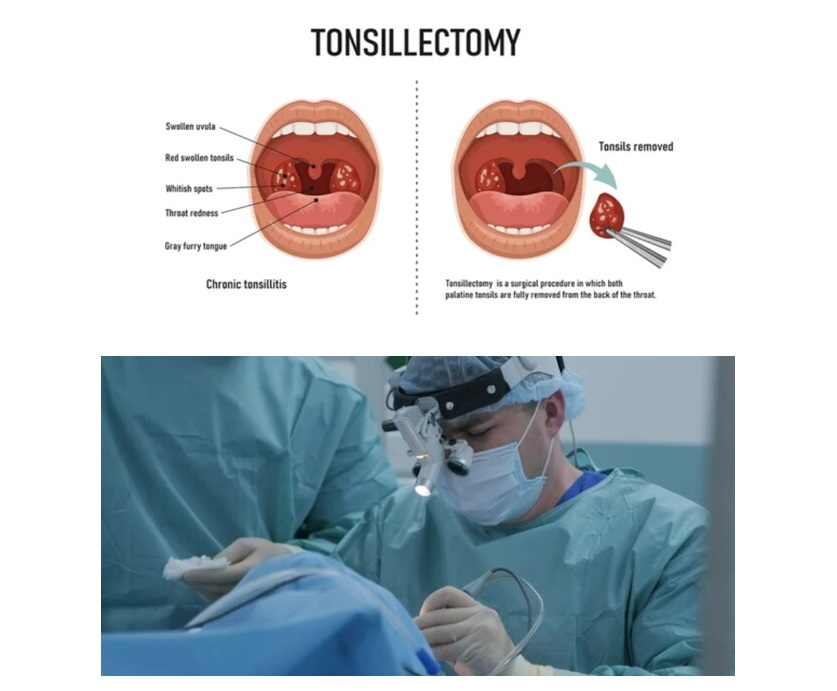A tonsillectomy is a surgical procedure to remove the tonsils, which are two small lymphoid tissues located at the back of your throat. The tonsillectomy surgery is often performed to address recurrent tonsillitis, difficulty breathing due to enlarged tonsils, or other related issues.
Here’s what you can generally expect after a tonsillectomy:
1) Immediate Recovery
a) Post-Anesthesia Care:
You will spend a few hours in a recovery room immediately after the surgery, where your vital signs will be monitored until you wake up completely from anesthesia.
You will be advised to be NPO (Nil per oral) for 6 hours after surgery, It means, the patient will not be allowed to take anything at all from mouth means NO FOOD, NO WATER for 6 hours in the immediate post-op period
b) Sore Throat:
You will likely experience a sore throat immediately after the surgery, a common side effect.
2) Pain and Discomfort
a) Pain Management:
The ENT doctor will prescribe pain medications to manage post-operative pain. It’s essential to take the medications as directed and not to wait until the pain becomes severe.
b) Throat Pain:
Sore throat and pain can persist for a week or more, but it typically improves gradually with each passing day.
3) Diet and Fluids After a Tonsillectomy Surgery
a) Liquid Diet:
Initially, you’ll be advised to consume a liquid or soft diet to avoid irritation to the surgical site. Popsicles, ice cream, and lukewarm soup are common choices.
b) Hydration:
It’s crucial to stay well-hydrated. Drinking water can help soothe the throat and prevent dehydration.
c) Chewing Gum:
Many times patients are so apprehensive after the surgery that they do not accept even a liquid diet with a fear of pain at the surgical site. Hence, patients are encouraged to chew a piece of chewing gum and swallow its juices. This not only promotes the swallowing function of the patient post-surgery, but it also takes the fear out of the patient that swallowing is not going to be painful post-surgery,
4) Activity and Rest
a) Rest:
Adequate rest is essential for the healing process. You may be advised to take it easy for a week or more, avoiding strenuous activities.
b) Return to Normal Activities:
Your ability to return to regular activities will depend on your individual recovery and the advice of your healthcare provider.
5) Follow-up Appointments
Check-ups:
You will likely have follow-up appointments with your surgeon to monitor your recovery and address any concerns.
6) Potential Complications
a) Bleeding:
Bleeding is one of the most dreadful complications of this surgery. While uncommon, some individuals may experience postoperative bleeding either in the immediate postoperative period, sometimes within 24 hours of surgery, and in a few cases within 10 days of surgery.
It’s crucial to follow your surgeon’s instructions regarding activity restrictions and care to minimize this risk.
b) Infection:
There is a risk of infection after surgery, so it’s essential to follow proper hygiene and take any prescribed antibiotics.
c) Voice Changes:
Temporary Change in voice is very very rare. This is not because of the tonsillectomy surgery per se, but it could be a complication of endotracheal intubation.
Endotracheal intubation is an important step while inducing general anesthesia in the patient before tonsillectomy surgery. The endotracheal tube passes through between the vocal cords and in rare instances may injure the vocal cords causing mild hoarseness in the post-op period.This is mostly temporary and the patient’s voice comes back to normal in a few days.
Another rare cause of this temporary voice change could be the swelling and irritation of the throat.
It’s important to note that individual experiences can vary, and your recovery may differ from others. Always follow your healthcare provider’s post-operative instructions and contact them if you have any concerns or experience unusual symptoms.
THANK YOU
MEDICAL ADVICE DISCLAIMER:
This blog including information, content, references, and opinions is for informational purposes only.
The Author does not provide any medical advice on this platform.
Viewing, accessing, or reading this blog does not establish any doctor-patient relationship.
The information provided in this blog does not replace the services and opinions of a qualified medical professional who examines you and then prescribes medicines.
If you have any questions of a medical nature, please refer to your doctor or the qualified medical personnel for evaluation and management at a clinic/hospital near you.
The content provided in this blog represents the Author’s own interpretation of research articles.
